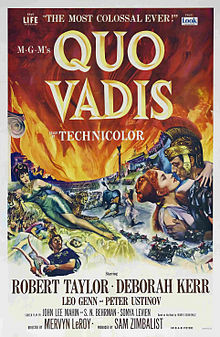| Quo Vadis | |
|---|---|
 Theatrical release poster | |
| Directed by | Mervyn LeRoy |
| Screenplay by | S. N. Behrman Sonya Levien John Lee Mahin |
| Based on | Quo Vadis by Henryk Sienkiewicz |
| Produced by | Sam Zimbalist |
| Starring | Robert Taylor Deborah Kerr Leo Genn Peter Ustinov |
| Cinematography | Robert Surtees William V. Skall |
| Edited by | Ralph E. Winters |
| Music by | Miklós Rózsa |
Production company | |
| Distributed by | Loew's, Inc. |
Release date |
|
Running time | 171 minutes |
| Country | United States |
| Language | English |
| Budget | $7.6 million[1] |
| Box office | $21 million |
Quo Vadis (Latin for "Where are you going?") is a 1951 American religious epic film set in ancient Rome during the final years of Emperor Nero's reign, based on the 1896 novel of the same title by Polish Nobel Laureate author Henryk Sienkiewicz. Produced by Metro-Goldwyn-Mayer and filmed in Technicolor, it was directed by Mervyn LeRoy from a screenplay by S. N. Behrman, Sonya Levien, and John Lee Mahin. It is the fourth screen adaptation of Sienkiewicz's novel. The film stars Robert Taylor, Deborah Kerr, Leo Genn, and Peter Ustinov, and features Patricia Laffan, Finlay Currie, Abraham Sofaer, Marina Berti, Buddy Baer, and Felix Aylmer. Future Italian stars Sophia Loren and Bud Spencer appeared as uncredited extras. The score is by Miklós Rózsa and the cinematography by Robert Surtees and William V. Skall. The film was released by Metro-Goldwyn-Mayer on November 2, 1951.
The story, set between 64–68 AD, combines both historical and fictional events and characters, and compresses the key events of that period into the space of only a few weeks. Its main theme is the Roman Empire’s conflict with Christianity and persecution of Christians in the final years of the Julio-Claudian line. Unlike his illustrious and powerful predecessor, Emperor Claudius, Nero proved corrupt and destructive, and his actions eventually threatened to destroy Rome's previously peaceful social order. The title refers to an incident in the apocryphal Acts of Peter.[2]
The film was nominated for eight Academy Awards, including Best Picture, and it was such a huge box office success that it was credited with single-handedly rescuing MGM from the brink of bankruptcy. Peter Ustinov won the Golden Globe Award for Best Supporting Actor – Motion Picture, and Robert Surtees and William V. Skall won the award for Best Cinematography.[3]
- ^ Hall, Sheldon; Neale, Steve (2010). Epics, Spectacles, and Blockbusters: A Hollywood History. Detroit, MI: Wayne State University Press. p. 137. ISBN 978-0-8143-3008-1.
- ^ The words "quo vadis" as a question occur five times in the Latin Bible – in Genesis 16:8, Genesis 32:17, Judges 19:17, John 13:36, and John 16:5.
- ^ "Quo Vadis". www.goldenglobes.com. Retrieved 2022-03-17.